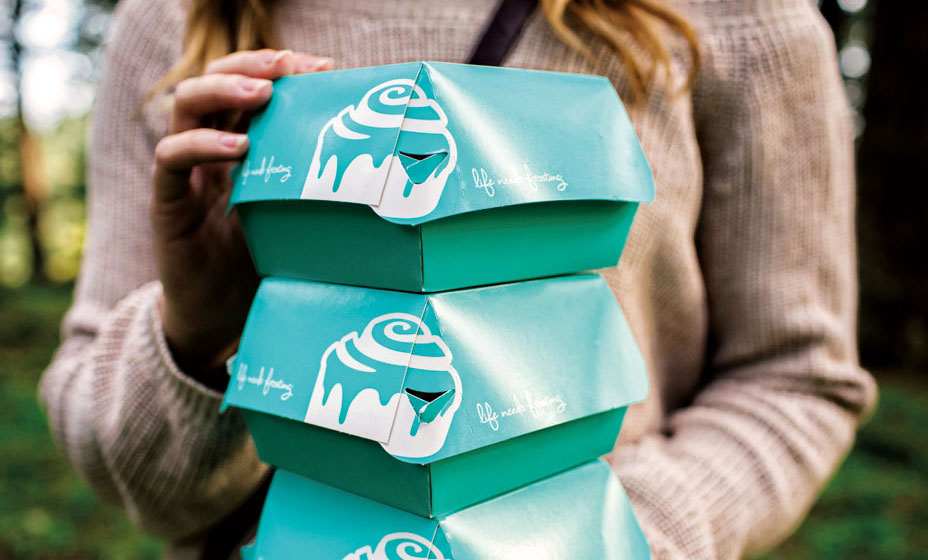Lovers of gooey sweet treats may think they know Cinnabon’s menu inside and out, but that doesn’t stop many of them from visiting the online menu pages repeatedly. Beyond updated offerings, returning guests can see photos and comments from their fellow Cinnabon fans, possibly people they know personally. Anyone who posts on social media with #Cinnabon has a chance of seeing their photography or witty comments on the official website itself.
The change in platforms elevates Cinnabon’s community engagement to another level. People enjoy seeing their photos and notes on Instagram, and seeing them on the official website does even more to make guests feel that they are part of the Cinnabon family. “And they really are,” says Victoria Nielsen, senior social media manager for Cinnabon and sister concept Moe’s Southwest Grill. “Every person who comes by the bakery we are appreciative of, and this is a way of giving them a thank you.”
User-generated content has been popular in the limited-service space for years as a facet of social media marketing. But while it is related to social media, customer-generated content can act as its own powerful marketing tool. Many limited-service concepts continually seek ways to best use the content, acquire more of it, and augment its efficacy beyond the newsfeed.
“The more customer-generated content a business gets, the more authentic word-of-mouth marketing they get. That’s the most valuable kind of marketing there is,” says Matt Gibbs, cofounder and CMO of UPshow. The Chicago-based company provides restaurants and other venues with the ability to turn TV screens into in-house marketing channels, often featuring user-created content.
At Cinnabon, using customer-generated photos on the Instagram page and website initially started as a way to drive efficiency. Its social marketing team is small, and posting content from customers offered enough material to update the brand’s Instagram page multiple times a day.
But Nielsen quickly saw that user-generated content did more than keep the Instragram page fresh. “It also brings a sense of community,” she says. “People will see that we posted their photo and say things like, ‘Thank you for posting this. I’ve loved Cinnabon for years and feel like part of the family.’”
That enthusiasm has led to enormous growth in Instagram followers. When fans see Cinnabon sharing a friend’s post, they are more likely to follow the brand. Furthermore, fans tag Cinnabon in posts more than ever because they are eager to be featured on the brand’s Instagram or official website.
At Epic Burger, a fast casual operating eight stores in the Chicago area, user-generated content makes up such a significant portion of its social media marketing that the company has a branded hashtag devoted entirely to it. #EpicFanPhoto has led to increased followers and a growing community that comments on one another’s Instagram photos.
Selected user-generated content appears on Epic Burger’s Instagram and other social media accounts. Marketing coordinator Spencer Most reaches out to customers if the brand decides to use their photos. The interaction builds relationships, increases loyalty, and helps Most better understand Epic Burger’s following.
Similar to Cinnabon, Epic Burger has seen its fan base grow as consumers view their friends’ posts. “You are much more likely to trust something that your friend posted than a stranger,” Most says.
After creating #EpicFanPhoto, the brand decided to integrate even more user-generated content into the Epic Burger experience. It partnered with UPshow and turned TVs into branded marketing screens complete with tons of guest photos.
Now Epic Burger’s TVs play a rotation of ads and photos taken by customers. The screens show a constant call to action: If guests post to social media with #EpicFanPhoto, their photo will appear on TV. And it does, within 30 seconds. A 24/7 team of screeners assesses the photo for inappropriate content, and, once cleared, it is displayed. It creates what Gibbs calls a “jumbotron effect.” It plays to people’s egos and gives them 15 seconds of fame.
“The instant gratification is everything,” Gibbs says. “It creates a contagious, holy cow moment. People get excited and cause a bit of commotion. That drives other people in the restaurant to post.”
But sharing fan-generated content isn’t simply a matter of reposting anything that uses a branded hashtag. Social media managers have to sift through that content and decide what to feature.
Cinnabon prioritizes photos in which “the product looks yummy,” Nielsen says. She also keeps photos in line with Cinnabon’s aesthetics and on-trend with influential images.
Analyzing user-generated content also gives brands insights into their customers. Epic Burger’s Most pays attention to the verbiage they use and if they write about particular features more than others. UPshow creates a database for its clients so they can see users who posted. The database helps brands to send a tailored message with a thank you or a special deal.
That kind of contact furthers the relationship between brand and customer, which is, ultimately, what user-generated content is all about.
“Fans these days are so savvy. They see right through marketing gimmicks. We’re trying to be our authentic selves and encourage them to be their authentic selves. Consumers really appreciate that because then they’re part of the story with us,” Nielsen says.
This story originally appeared in QSR’s July 2017 issue with the title “Your Biggest Fan.”








